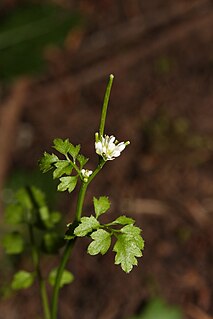
Cardamine is a large genus of flowering plants in the mustard family, Brassicaceae, known as bittercresses and toothworts. It contains more than 200 species of annuals and perennials. Species in this genus can be found worldwide, except the Antarctic, in diverse habitats. The name Cardamine is derived from the Greek kardamon, cardamom, an unrelated plant in the ginger family, used as a pungent spice in cooking.

Anthocharis cardamines, the orange tip, is a butterfly in the family Pieridae, which contains 1100 species of butterfly. A. cardamines is mainly found throughout Europe and temperate Asia (Palearctic) The males feature wings with a signature orange pigmentation, which is the origin of A. cardamines' common name.

Anthocharis midea, the falcate orangetip, is a North American butterfly that was described in 1809 by Jacob Hübner. It belongs to the family Pieridae, which is the white and sulphurs. These butterflies are mostly seen in the eastern United States, particularly in Texas and Oklahoma. They eat the nectar of violets and mustards. They tend to live in open, wet woods along waterways, in open swamps, and less often in dry woods and ridgetops. This species is a true springtime butterfly, being on the wing from April to May.

Cardamine pratensis, is a flowering plant in the family Brassicaceae, native throughout most of Europe and Western Asia. The specific name pratensis is Latin for "meadow."

Cardamine californica, or milkmaids, is a flowering plant in the family Brassicaceae, native to western North America from Washington to California and Baja California. It is common in a variety of habitats including shady slopes, open woodlands, chaparral and grasslands in the winter and early spring. In the San Francisco Bay Area, it is one of the first wildflowers to bloom, with blossoms from January to May.

Cardamine hirsuta, commonly called hairy bittercress, is an annual or biennial species of plant in the family Brassicaceae, and is edible as a bitter herb. It is common in moist areas around the world.

Cardamine concatenata, the cutleaved toothwort, crow's toes, pepper root or purple-flowered toothwort, is a flowering plant in Brassicaceae. It owes its name to the tooth-like appearance of its rhizome. It is a perennial plant woodland wildflower native to eastern North America. It is considered a spring ephemeral and blooms in March, April, and/or May.

Cardamine bulbosa, commonly called bulbous bittercress, is a perennial plant in the mustard family. It is native to a widespread area of eastern North America, in both Canada and the United States. Its natural habitat is moist soils of bottomland forests and swamps, often in calcareous areas.

Cardamine impatiens, the narrowleaf bittercress or narrow-leaved bitter-cress, is a plant species in the genus Cardamine of the family Brassicaceae. It is a slender, biennial herb, that produces sterile leaves in the first year, one to several flowering stems during the next. Its leaves are pinnate with several pairs of lanceolate, dentate leaflets and a terminal, slightly longer leaflet. The short petals surpass the calyx by half of its length. The seeds are arranged in one row on each side of the central membrane of the narrow pod and are ejected out in a shower due to the tension formed as the seed pod (silique) dries. It grows on walls, open ground in shady places in forests usually disturbed by man.

Cardamine breweri is a species of cardamine known by the common name Brewer's bittercress. It is native to western North America from British Columbia to California to Colorado, where it grows in coniferous forests, particularly in wet bog habitats.

Cardamine nuttallii is a species of cardamine known by the common name Nuttall's toothwort. It is native to western North America from British Columbia to California, where it grows in moist mountain habitats.

Cardamine oligosperma is a species of Cardamine known by the common name little western bittercress. It is native to western North America from Alaska to California to Colorado, where it grows in moist mountain habitats.
Cardamine pachystigma is a species of Cardamine known by the common name serpentine bittercress. It is endemic to California, where it grows in rocky mountainous areas, often on serpentine and volcanic soils.

Discodoris is a genus of sea slugs, dorid nudibranchs, shell-less marine gastropod molluscs in the family Discodorididae.

Tayuva lilacina is a species of sea slug, a dorid nudibranch, shell-less marine gastropod mollusks in the family Discodorididae. A number of species descriptions are considered to be synonyms.

Echeveria lilacina, common name ghost echeveria or Mexican hens and chicks, is a species of succulent plants in the genus Echeveria belonging to the family Crassulaceae. The genus name Echeveria was given in honor of the 18th century Mexican botanist and painter Atanasio Echeverría y Godoy, famous for his paintings of plants.
Eois lilacina is a moth in the family Geometridae. It is found in Peru.
Venusia lilacina is a moth in the family Geometridae first described by William Warren in 1893. It is found in China, Nepal and India.
Trichordestra lilacina, the aster cutworm, is a species of cutworm or dart moth in the family Noctuidae. It is found in North America.













